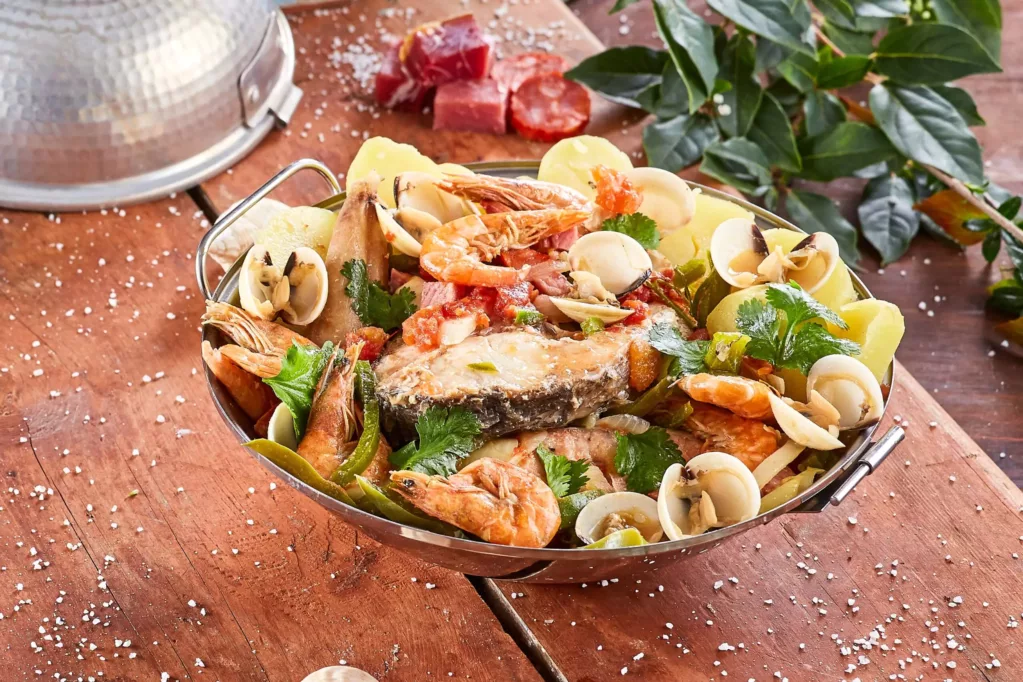6 Traditional Dishes you have to try in Ferragudo
Algarve, the southernmost region of Portugal, is known for its stunning beaches, picturesque towns, and rich history. But the region is also famous for its traditional cuisine, which is a blend of seafood, meat, vegetables, and spices. In this blog post, we will explore the best traditional dishes you can find in Ferragudo, Algarve.
1.Cataplana de Marisco

Cataplana de Marisco is a traditional seafood dish that originated in Algarve. It is a stew made with a variety of seafood, including clams, mussels, prawns, and fish. The dish is cooked in a traditional copper pan called a cataplana, which gives it its unique flavor. The seafood is cooked with onions, tomatoes, garlic, and white wine, and seasoned with herbs such as coriander and parsley. The dish is usually served with bread or rice.
Cataplana is not only the name of this shell-shaped copper kitchen utensil, but also of the delectable dishes made in it. The cataplana is made up of two concave parts joined by a hinge that seals all the ingredients with the help of two side fasteners, ensuring that all the flavors and aromas are retained and mixed together like no other kitchen utensil.
The food is cooked slowly and at low temperatures using airtight steam cooking. This method of cooking imparts a distinct flavor to the food that you will want to replicate. Originally made of copper, cataplanas are now available that can be used on modern induction or glass ceramic hobs.
Little is known about the cataplana’s origins in the Algarve, but everything points to it appearing during the period when the Algarve was under Arab rule. Its design may have been inspired by the numerous bivalves that inhabit the Ria Formosa. Documents from antiquity describe the opening of a hole in the ground, where the cataplana was placed over glowing embers and covered with sand. This type of outdoor cooking is documented in historical records, and given the shape of the cataplana, it is entirely natural that it occurred.
Even today, this kitchen utensil is handcrafted by artisans who shape copper with slow, precise hammer blows that give it all its charm. There are numerous dishes that can be prepared in a cataplana. Among the many recipes available, the Portimonense Clams, Clams in Cataplana, Partridges with Clams in Cataplana, Pork Cataplana with Clams, and Monkfish Cataplana stand out.
If you ask the locals what dishes to try when visiting the Algarve, you will almost always get answers that involve fresh seafood, such as Monkfish rice, Fish cataplanas, and the famous Grilled Sardines. While I agree that the Algarve is one of the best places in Portugal for fresh fish and seafood, some of the dishes, especially in tourist areas, can be quite pricey.
2.Chicken piri piri
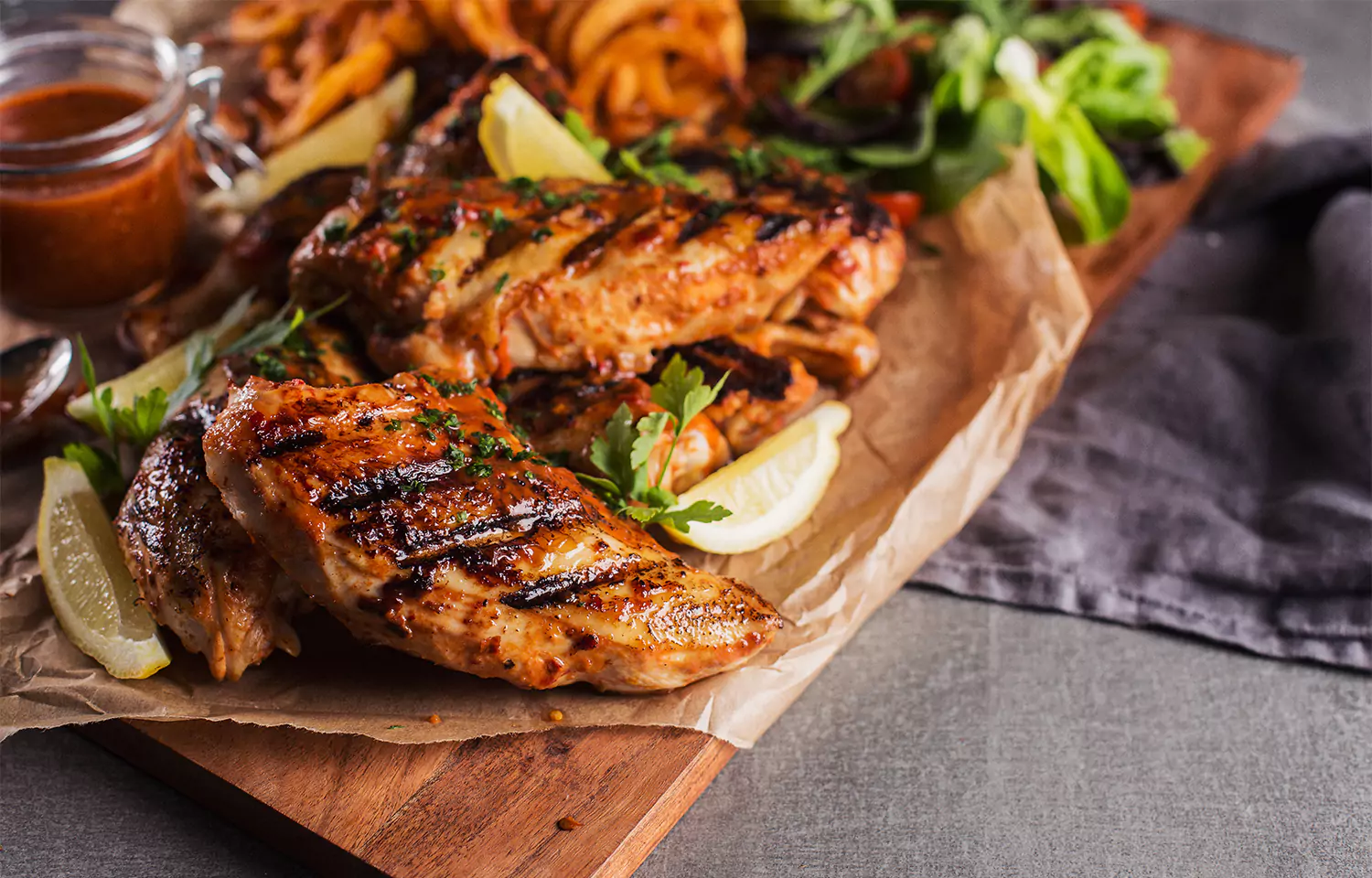
Chicken Piri Piri is an equally delicious and traditional Portuguese dish to try if you’re traveling on a budget or don’t like seafood. The Algarve is well-known as its residence.
What is Frango Assado’s Chicken Piri Piri?
A popular Portuguese dish is Chicken Piri-Piri or Frango Piri-Piri. It’s just a butterflied grilled chicken with fries and salad. The piri-piri chicken is distinguished from other grilled chickens by the chilli glaze it receives before grilling. It is available in many restaurants and churrasqueiras (barbecue restaurants) in Portugal. You can usually order an entire chicken or just half of it, with or without the chili sauce. Because most restaurants do not serve it hot, those who prefer more heat can request more piri-piri sauce.
The History of Piri-Piri
In Portugal, the name Piri-piri refers to a chilli variety of the species Capsicum frutescens, which is also known as malagueta peppers. What’s the distinction between piri-piri and malagueta? Although some people believe they are different varieties, they are actually the same plant. The chilis vary in size, maturity stage, and heat. Piri-piri chilies are smaller and hotter than malagueta chilies. They are approximately 2-3cm in length and are considered extremely hot, with scoville heat units ranging from 50,000 to 175,000. (SHU). If you’re unfamiliar with the Scoville scale, a common pepper, such as a jalapeo, ranges from 3,500 to 8,000 SHU. Piri piri peppers are significantly hotter.
Is it peri peri or piri piri?
Piri piri is the Portuguese term for it. However, it is much more commonly known as peri peri chicken on a global scale. Piri piri is thought to have originated from the Swahili-li Pilipili, which means pepper. Piri piri, Portugal and its ex-colonies. Peri peri, both internationally and in English. Perhaps we can blame the South African restaurant chain Nando’s for popularizing the peri peri spelling in the UK as well!
3.Arroz de Marisco
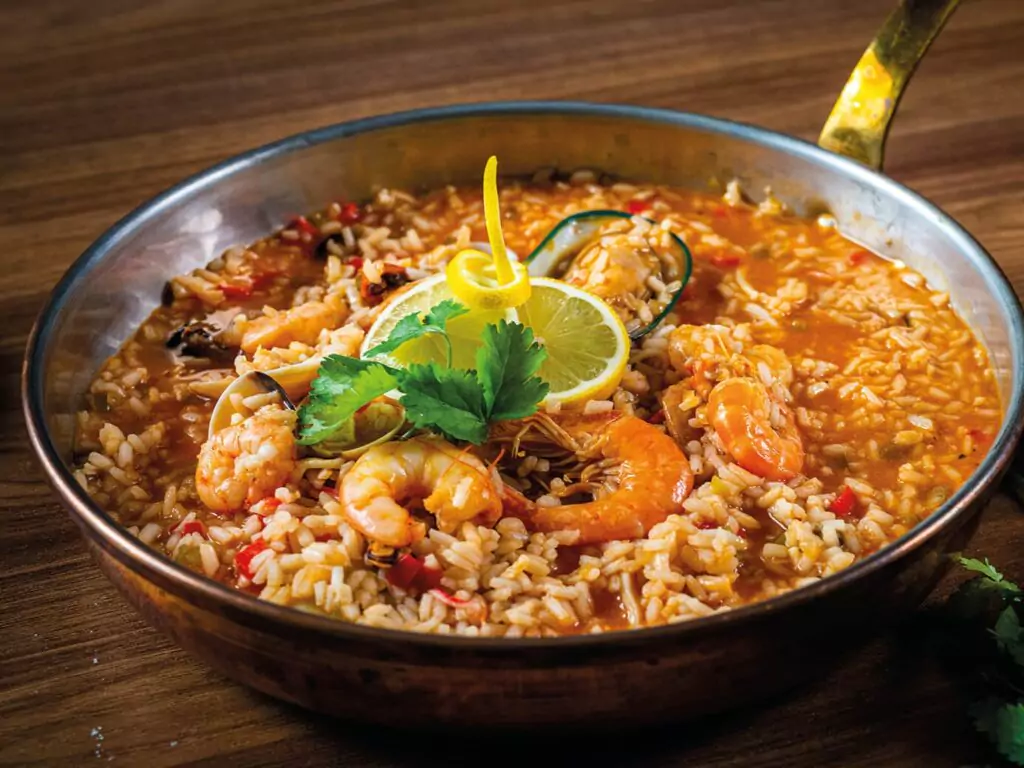
Arroz de Marisco is a traditional seafood dish from Portugal. Despite its association with a beach in central Portugal – Praia de Vieira de Leiria – it is widely available in many restaurants along the coast of Portugal. It is typically made up of a variety of shellfish, peppers, tomatoes, fresh herbs, and short-grain rice, resulting in a decadent and delicious dish. For those who are still not convinced, it was named one of the 7 Wonders of Portuguese Gastronomy in 2011.
What Seafood is usually in Arroz de Marisco?
This recipe calls for three kinds of shellfish: prawns, clams, and mussels. However, as with many Portuguese recipes, the ingredient list varies greatly. Some of the recipes we found included lobster and crab meat. However, the type of shellfish you use will be determined by the ingredients available, your personal preferences, and your budget. We believe it is critical to use fresh prawns because their skin serves as the foundation for the broth used to cook the rice. Keep in mind that any additional shellfish will add additional flavors to the broth and complexity to your dish.
4.Sardinhas Assadas
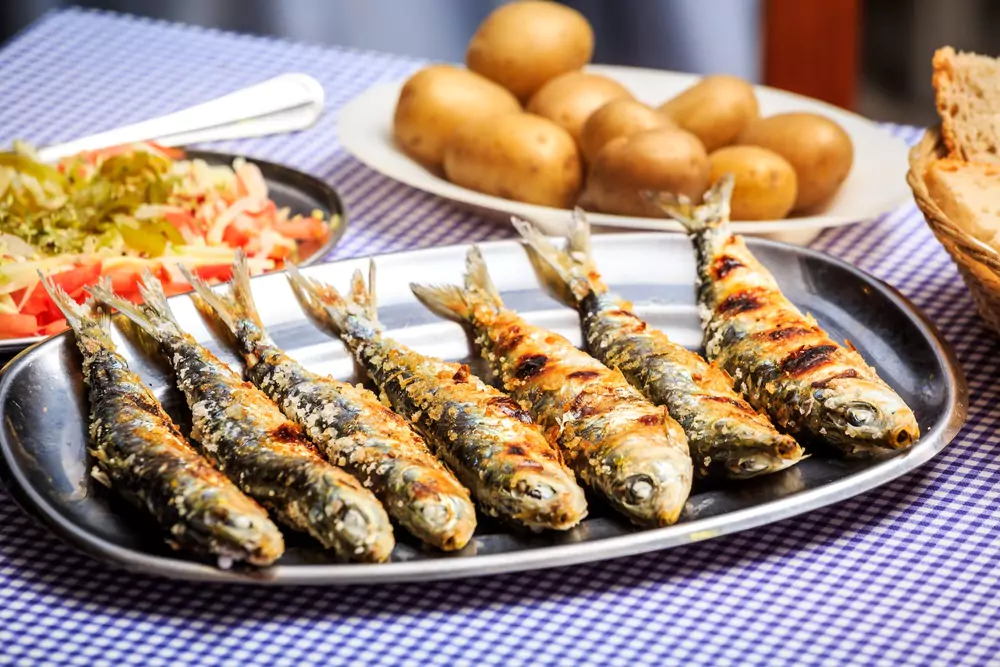
Sardinhas Assadas is a traditional grilled sardine dish that is popular in Algarve. Sardines are abundant in the region and are a staple of the local diet. The fish are grilled over charcoal and served with a side of bread and salad. The dish is simple but flavorful, and the charred skin gives the sardines a smoky taste.
Sardines are synonymous with the Algarve; every year, there is a Sardine Festival in Portimão that celebrates celebrates the long and delicious history and traditions of these salty pieces of fish.
When most people think of sardines, they think of cans from the back of the cupboard, but in the Algarve, they know their sardines and, more importantly, how to cook them to perfection, making the Sardine Festival in Portimão a must for sardine fans and those interested in trying real sardines!
5.Caldeirada de Peixe
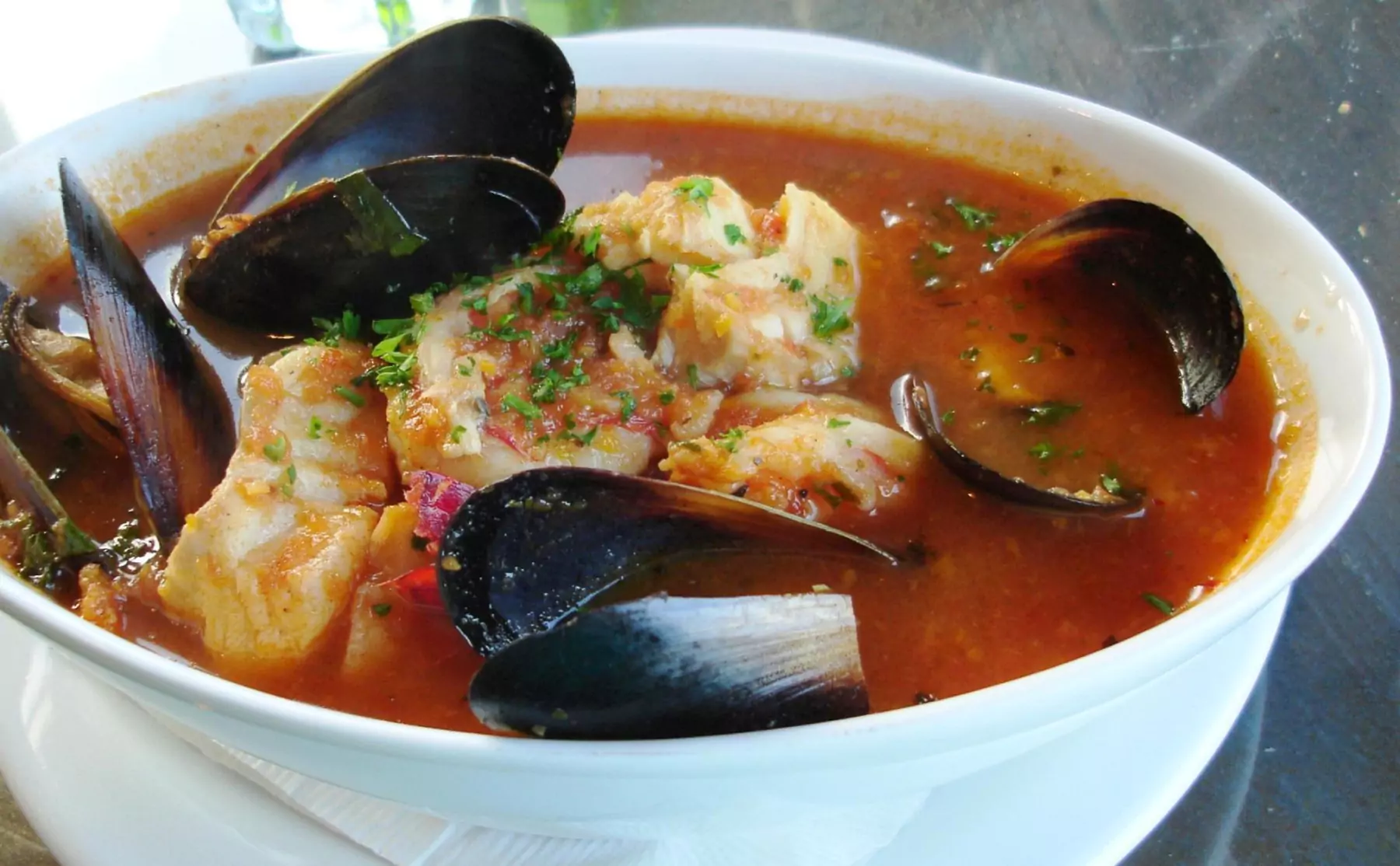
Caldeirada is a traditional Portuguese and Galician stew of various fish, vegetables, spices, and herbs in a rich broth. It is thought to have been invented by fishermen in need of a filling meal after a day at sea. Back then, the fish used varied depending on the catch of the day and were frequently those with the least commercial value. Nowadays, some ingredient variations exist between regions, and a caldeirada from the Algarve will differ from a caldeirada from the region of Lisbon. Regardless of regional variations, they all adhere to a specific fish-vegetable ratio and are prepared in a similar manner, resulting in an incredible meal after a day on the beach, even if you aren’t fishing!
Caldeirada Varieties by Region
This well-known dish, like many others in traditional Portuguese cuisine, varies by region. Grey mullet, seabream, eel, and monkfish are the most commonly used fish in the south. Ray, monfish, squid, and clams are included in the Caldeirada poveira from Póvoa de Varzim in the northern region, as well as potatoes, peppers, and onion. Dogfish, toadfish, and monkfish are used in Setbal, along with peppers, potatoes, onions, and herbs such as mint, coriander, and thyme. According to the locals, the key ingredients of Setbal’s caldeirada are the livers of the fish used and small short pasta added at the end of the preparation.
What does the word Caldeirada mean?
The word caldeirada is a combination of the word caldeira, which means boiler, and refers to the pot in which the ingredients are stewed, and the suffix ada, which refers to sets and food preparations such as feijoada (bean stew) and sardinhada (grilled sardines). Caldeirada is the generic Portuguese name for a variety of fish stews, so you’ll often see more specific names based on the region or ingredients used in the preparation, such as Caldeirada à Algarvia.
What exactly is the distinction between Caldeirada and Cataplana?
Those who are familiar with the Algarve’s cataplana may be wondering how it differs from a caldeirada. While the ingredients in both dishes are similar, a cataplana refers to the unique preparation made in a cataplana: the two-sided copper pots found throughout the Algarve. Unlike the caldeirada, the ingredients in the cataplana are gently steamed in a sealed pot, similar to what happens in a pressure cooker.
6.Polvo à Lagareiro
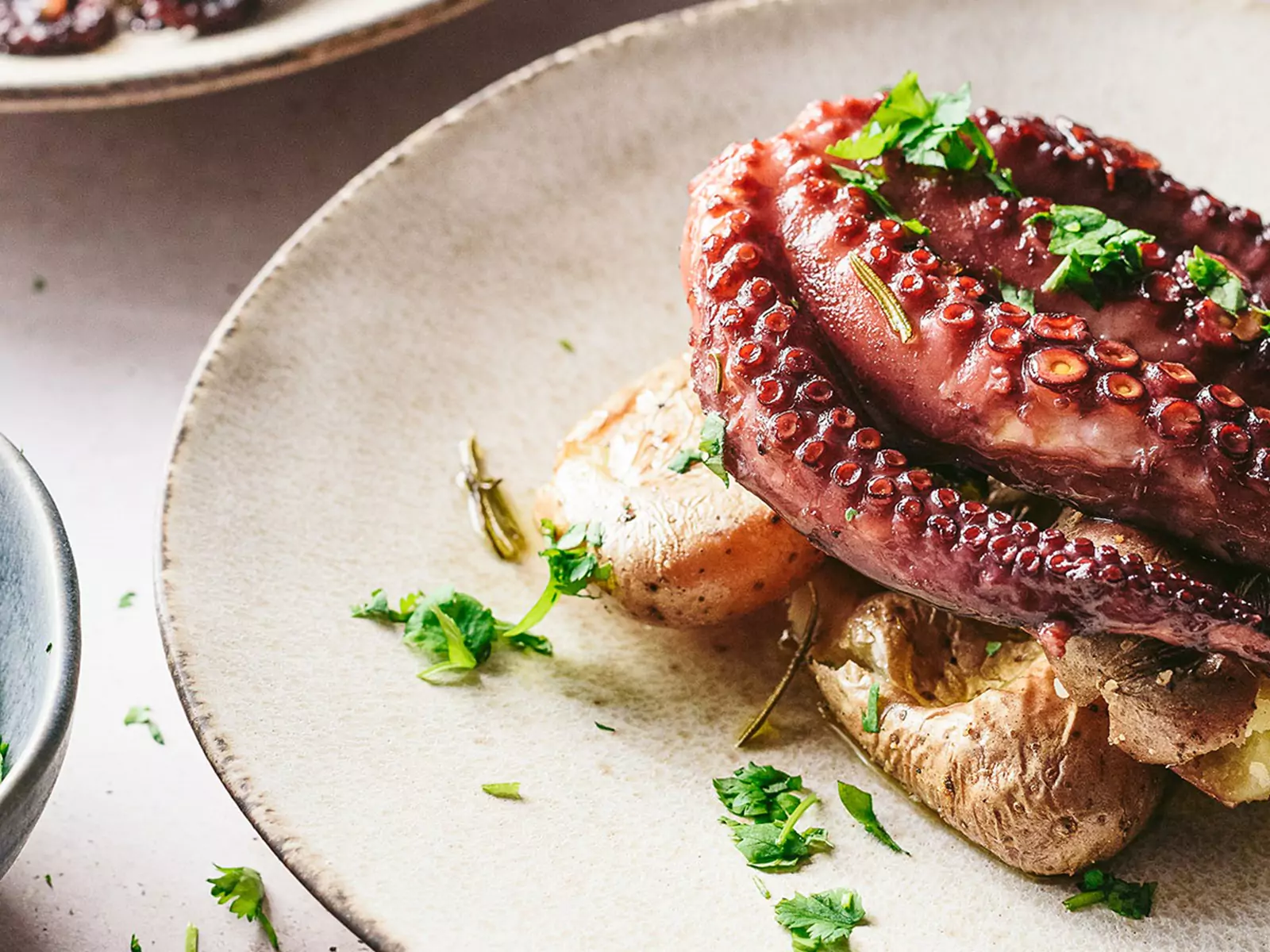
Polvo à lagareiro is a traditional Portuguese seafood dish that consists of boiled and baked octopus with mashed potatoes in a garlic-herbed oil. Polvo à lagareiro is a popular dish on many tables across the country, though many claim it originated in the Beiras, a region located between the Douro and Tagus rivers.
Polvo à lagareiro, or lagareiro-style octopus, is a variation on the more commonly eaten bacalhau à lagareiro, which features cod. Cod is undoubtedly one of the most popular dishes in Portugal, and it is commonly served salted, a tradition that dates back before refrigeration. Boiled or baked potatoes are smashed, salted, and tossed with seafood in olive oil with cilantro or other herbs in the lagareiro preparation. Bacalhau à lagareiro typically includes salted cod, which has been a fall and winter staple food for centuries, but other seafood, such as the octopus featured in polvo à lagareiro, has recently been prepared in this manner.
Octopus is a popular seafood all over the world, but the Portuguese have a special fondness for the tentacled creatures. Cooking with octopus may be intimidating for some, but the beauty of cooking polvo is the ease with which it can be prepared. Octopi are best boiled, lightly braised, or sun-dried and then grilled (as is common in Portugal and throughout the Mediterranean). When salting octopi, use caution because salt can cause the skin to harden when boiled in salted water. This can be avoided by lightly pounding the fish before preparing—this is often done by fishmongers against rocks after the boats come in off the ocean. In a Portuguese home, cooking and serving octopus is often a sign of celebration or the return of family from the fishing boats.

